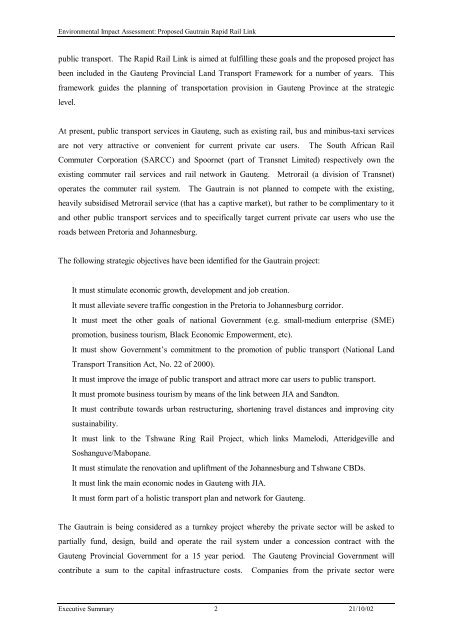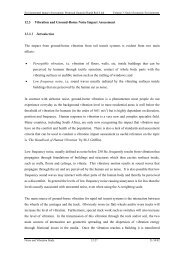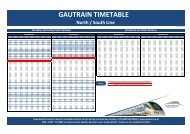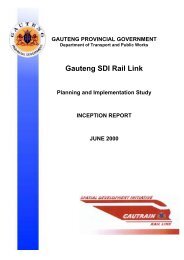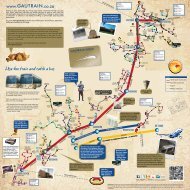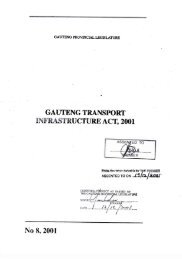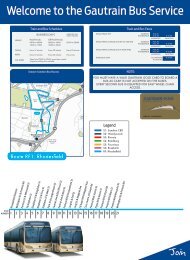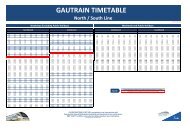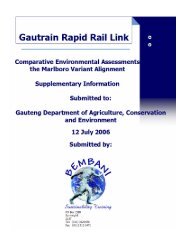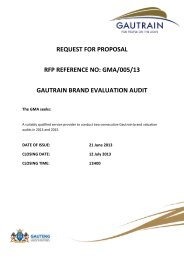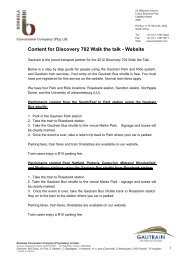environmental impact assessment for the proposed gautrain rapid ...
environmental impact assessment for the proposed gautrain rapid ...
environmental impact assessment for the proposed gautrain rapid ...
You also want an ePaper? Increase the reach of your titles
YUMPU automatically turns print PDFs into web optimized ePapers that Google loves.
Environmental Impact Assessment: Proposed Gautrain Rapid Rail Link<br />
public transport. The Rapid Rail Link is aimed at fulfilling <strong>the</strong>se goals and <strong>the</strong> <strong>proposed</strong> project has<br />
been included in <strong>the</strong> Gauteng Provincial Land Transport Framework <strong>for</strong> a number of years. This<br />
framework guides <strong>the</strong> planning of transportation provision in Gauteng Province at <strong>the</strong> strategic<br />
level.<br />
At present, public transport services in Gauteng, such as existing rail, bus and minibus-taxi services<br />
are not very attractive or convenient <strong>for</strong> current private car users. The South African Rail<br />
Commuter Corporation (SARCC) and Spoornet (part of Transnet Limited) respectively own <strong>the</strong><br />
existing commuter rail services and rail network in Gauteng. Metrorail (a division of Transnet)<br />
operates <strong>the</strong> commuter rail system. The Gautrain is not planned to compete with <strong>the</strong> existing,<br />
heavily subsidised Metrorail service (that has a captive market), but ra<strong>the</strong>r to be complimentary to it<br />
and o<strong>the</strong>r public transport services and to specifically target current private car users who use <strong>the</strong><br />
roads between Pretoria and Johannesburg.<br />
The following strategic objectives have been identified <strong>for</strong> <strong>the</strong> Gautrain project:<br />
It must stimulate economic growth, development and job creation.<br />
It must alleviate severe traffic congestion in <strong>the</strong> Pretoria to Johannesburg corridor.<br />
It must meet <strong>the</strong> o<strong>the</strong>r goals of national Government (e.g. small-medium enterprise (SME)<br />
promotion, business tourism, Black Economic Empowerment, etc).<br />
It must show Government’s commitment to <strong>the</strong> promotion of public transport (National Land<br />
Transport Transition Act, No. 22 of 2000).<br />
It must improve <strong>the</strong> image of public transport and attract more car users to public transport.<br />
It must promote business tourism by means of <strong>the</strong> link between JIA and Sandton.<br />
It must contribute towards urban restructuring, shortening travel distances and improving city<br />
sustainability.<br />
It must link to <strong>the</strong> Tshwane Ring Rail Project, which links Mamelodi, Atteridgeville and<br />
Soshanguve/Mabopane.<br />
It must stimulate <strong>the</strong> renovation and upliftment of <strong>the</strong> Johannesburg and Tshwane CBDs.<br />
It must link <strong>the</strong> main economic nodes in Gauteng with JIA.<br />
It must <strong>for</strong>m part of a holistic transport plan and network <strong>for</strong> Gauteng.<br />
The Gautrain is being considered as a turnkey project whereby <strong>the</strong> private sector will be asked to<br />
partially fund, design, build and operate <strong>the</strong> rail system under a concession contract with <strong>the</strong><br />
Gauteng Provincial Government <strong>for</strong> a 15 year period. The Gauteng Provincial Government will<br />
contribute a sum to <strong>the</strong> capital infrastructure costs. Companies from <strong>the</strong> private sector were<br />
Executive Summary 2 21/10/02


